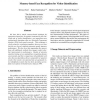Free Online Productivity Tools
i2Speak
i2Symbol
i2OCR
iTex2Img
iWeb2Print
iWeb2Shot
i2Type
iPdf2Split
iPdf2Merge
i2Bopomofo
i2Arabic
i2Style
i2Image
i2PDF
iLatex2Rtf
Sci2ools
FGR
2000
IEEE
2000
IEEE
Memory-Based Face Recognition for Visitor Identification
We show that a simple, memory-based technique for appearance-based face recognition, motivated by the realworld task of visitor identification, can outperform more sophisticated algorithms that use Principal Components Analysis (PCA) and neural networks. This technique is closely related to correlation templates; however, we show that the use of novel similarity measures greatly improves performance. We also show that augmenting the memory base with additional, synthetic face images results in further improvements in performance. Results of extensive empirical testing on two standard face recognition datasets are presented, and direct comparisons with published work show that our algorithm achieves comparable (or superior) results. Our system is incorporated into an automated visitor identification system that has been operating successfully in an outdoor environment since January 1999.
Appearance-based Face Recognition | Biometrics | Face Recognition | FGR 2000 | Visitor Identification |
| Added | 24 Aug 2010 |
| Updated | 24 Aug 2010 |
| Type | Conference |
| Year | 2000 |
| Where | FGR |
| Authors | Terence Sim, Rahul Sukthankar, Matthew D. Mullin, Shumeet Baluja |
Comments (0)

